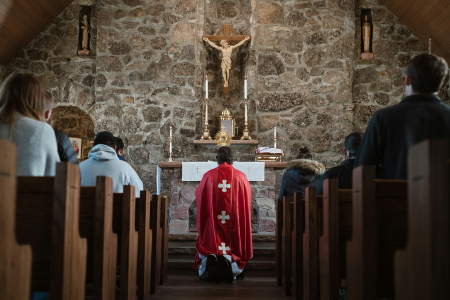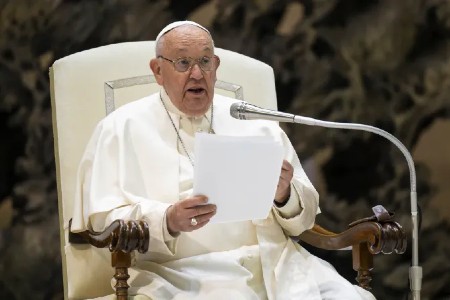We ask you, humbly: don't scroll away.
Hi readers, it seems you use Catholic Online a lot; that's great! It's a little awkward to ask, but we need your help. If you have already donated, we sincerely thank you. We're not salespeople, but we depend on donations averaging $14.76 and fewer than 1% of readers give. If you donate just $5.00, the price of your coffee, Catholic Online School could keep thriving. Thank you.Help Now >
Is a Mt. St. Helens eruption imminent? Here's the secret you're not being told
FREE Catholic Classes
A researcher, who has studied volcanoes for decades, has reached out to Catholic Online to share new information about volcanic activity in the Pacific Northwest. It appears activity is spiking in the region, and neither the public, nor geologists, may be fully aware of the risk, or what's truly going on. This researcher has also made a startling prediction.
Highlights
CALIFORNIA NETWORK (https://www.youtube.com/c/californianetwork)
5/18/2016 (7 years ago)
Published in Green
Keywords: Mt. St. Helens, volcano, magma, earthwuake, swarm, eruption, Mt. Rainier, Mt. Hood
LOS ANGELES, CA (California Network) - For hundreds of thousands of people who sleep in the shadow of picturesque, glacier capped Mt. Rainier, life is good. The region's economy is booming, El Nino has brought refreshing rain, and the long, lazy summer is about to begin. However, deep inside Mt. Rainier, a giant may be stirring, awakened by geologic processes that are barely understood.
This Wednesday, public officials in Washington state are holding a massive drill to prepare for a possible future eruption of any of the state's several volcanoes. May is Volcano Preparedness Month, and the 18th is the anniversary of Mt. St. Helen's eruption in 1980.
Several agencies, as well as the general public, will be involved in exercises designed to encourage preparedness and to practice responses to volcanic eruptions, including lahar mudflows.
The timing of these exercises is fortuitous, for as the drills get underway, Mt. St. Helens, Mt. Rainier, and now Mt. Hood are showing signs of simultaneous activity, chiefly noted by mutual earthquake swarms.
While public attention is focused on Mt. St. Helens, greater concern is privately expressed for Mt. Rainier. Covered in snow and ice, and close to population centers, particularly Tacoma, Seattle, and their suburbs, an event at Mt. Rainier could result in mass devastation.
Scientists have referred to Mt. Rainier as a "time bomb" and as "the most dangerous mountain in the United States," according to Eric Sorensen of the Seattle Times. The secret to the mountain's lethality is what makes it so attractive to residents. Its picturesque slopes, coated in blankets of snow and ice, can turn deadly within seconds.
A single moderate quake, or even a sudden failure of the mountain rock face, is all it takes to send sheets of ice and snow cascading down its slopes, where it melts and mixes with the stratovolcano layers forming an aggressive mudflow, known as a "lahar." These flows will be channeled into low-lying valleys areas and can run swiftly for miles before they slow and settle. Anything the path of a lahar is always destroyed or buried.
If the volcano does erupt, then the lahar scenario will play itself out with a hundredfold intensity. Instead of a single flow, there could be dozens, striking in waves. Such flows would be superheated by the volcanic activity and will be all the more lethal. Prehistoric flows have reached Puget Sound in the long centuries before human habitation.
At least 150,000 people in the region live on ancient lahar deposits. Some of these imperiled souls, in the town of Orting, are protected by an early warning system that will give, at best, a 40 minute warning for people to flee to higher ground. For people who are on foot, for the elderly, the sick, or the small, the time may be too short. Roads will jam with vehicles as people wreck, trying to get past one another on the way out of the area. The devastation will be substantial, even before the mudlfows reach the suburban communities below.
But what are the odds of such an event?
According to the USGS, there is a 1 in 10 risk of a lahar that reaches Puget Sound in a single lifetime.
And those dangers could be increasing by the day. According to our source, there has been an increase in activity at Mt. Rainier. While no scientist has yet predicted an imminent eruption at Mt. Rainier, the data may be disconcerting. At an Alaskan volcano, Kasotochi, in 2008, USGS volcano scientists were rescued just in time as the volcano went from a quiet state to an explosive eruption within 24 hours and with very little warning.
If Mt. Rainier erupts, it will likely be one of the most destructive disasters in American history. However, Mt. Rainier doesn't need to erupt to threaten lives and property. A good quake is all it may take to send rock and massive melting glaciers sliding down the mountain.
As alarming as it is to say, Mt. Rainier isn't the end of it.
Mt. St. Helens has also shown a spike in activity, even more intense than that observed at Mt. Rainier. The quakes are swarming, about 40 per week at present. The prediction from USGS geologist, Seth Moran, lead scientist at the Cascades Volcano Observatory, is that Mt. St. Helens is recharging its magma chamber for an eruption in "years to decades from now."
But can he be sure?
While Mt. St. Helens' magma is recharging at this time, and most recently, within the past few days, Mt. Hood has begun shaking too. About 100+ quakes have been observed within the past 2 days, by the time of this writing.
In breaking news, Geologist Scott Burns with Portland State University states that Mt Hood's new quake swarm indicates "it's a sign that magma is moving up."
As it turns out, there is a hypothesis that suggests why we're seeing rising levels of activity from three volcanoes simultaneously. The hypothesis suggests, this volcanic activity may be connected.
Indeed, in 2008, three nearby Alaskan volcanoes, similar in spacing of Mt. Rainier, Mt. St. Helens, and Mt Hood, all erupted within less than a month; Okmok Volcano erupted unexpectedly and explosively on July 12, followed by Cleveland Volcano, 100 miles away, on July 21, and then Kasatochi, unexpected and explosively, on August 7. These volcanoes sent ash plumes skyrocketing and caused commercial airline flights to be diverted or cancelled.
Conventional geology suggests a volcano is formed somewhat independently as the result of a very hot blob of magma rising to the Earth's surface, percolating up through cracks in the mantle. This is the prevailing theory. However, this hypothesis fails to account for progressive earthquake patterns, which progressed laterally between the Alaskan volcanoes, which suggests that volcanoes may be linked together, with long-running "radial dike" series of tubes connecting one magma chamber to another.
Supporting a possible interconnecting "pipeline supply" was the mystifying extrusion of nearly 102 million cubic yards of lava, over 15 months, from Mt. St. Helen's recent 2004 eruption. Geologists could not explain where this prolific magma was coming from since the mountain did not deflate its shape nor did the lava reveal any gasses characteristic of a deep magma source. In 2005, U.S. Geological Survey geologist Dave Sherrod admitted that it was not entirely clear where the volume of lava was coming from noting "That's one of the headscratchers, I guess."
Is it possible that interconnected deep plumes of magma exist beneath Washington and Oregon, which "radial dikes" may also recharge multiple volcanoes at one time? Or does one volcano set off another, then another?
And what if activity in one volcano could activate underground networks of "radial dike" crystallized magma, to influence events elsewhere? In the case of Okmok, Cleveland, and Kasatochi volcanoes there is some evidence to suggest this may be the case.
Still, present geologic theory is based on magma plumes and magma chambers while dismissing any connection between volcanoes in a chain. But the question merits further research. Even the recent "imaging magma under St. Helens" (iMUSH) magma chamber mapping study was unable to see only but the larger features. If scientists are wrong in missing these complex "radial dikes", then activity at Mt. St. Helens could trigger activity elsewhere. Is this what's happening as Rainier and Hood quiver to life?
According to our source, we are less than six months away from an eruption by at least one of these volcanoes. However, no scientist in the media is prepared to repeat such a claim. And they could be correct, it could be years, even decades before anything happens, but -just but, what if they're wrong?
And there's one more worrisome factor to be concerned about. That is the composition of the lava itself. In 1980, when Mt. St. Helens erupted, nay, exploded, it did so because the magma within it was rich in silica. In 2004, when it erupted again, the magma was poor in silica, and the volcano erupted meekly.
The problem is that scientists can't tell if the magma in Rainier, or St. Helens, or Hood, is rich or poor in silica before they erupt. This means all three volcanoes could erupt with great ferocity, blowing themselves apart as Mt. St. Helens did in 1980, or they could all erupt mildly, as in 2004.
And it's possible none of these three volcanoes will do anything in the near future. However, given historical patterns, we think this is the least likely outcome.
Get ready!
Preparedness is the key. When relocating to an area with active volcanoes, it is important to avoid situating oneself in close proximity to a potential hazard zone. Cities and communities should restrict development in such zones to minimize the danger to people and property when a volcano does awaken.
People in such regions should always have emergency supplies on hand, so they can flee at a moment's notice. A plan should be memorized by every person in a family, so separated family members know where to meet. Pets should be considered in the plan, but there may be some emergencies where pets cannot be accommodated. This should be taken into consideration when keeping pets. Insurance policies should be purchased and inventories sent to the insurers so valuable property can be replaced.
Planning, preparation and practice are key to surviving one of these events. Of course, the best way to survive is not to be near them when they happen.
The volcanoes of the Pacific Northwest have no regard for human life. They have stood tall for thousands of years, if not millions, periodically erupting right when they were ready to do so. They will continue to do so, and if the people who live in their shadows do not show proper respect, then these mighty, indifferent giants will burn, bury and destroy them too.
We will continue to provide reporting on this situation as it develops over the months to come.
NOTE: The researcher who shared this information with us has asked to remain anonymous. However, he has been researched and vetted by our editorial staff and we believe his credentials are sound.
--- The California Network is the Next Wave in delivery of information and entertainment on pop culture, social trends, lifestyle, entertainment, news, politics and economics.
We are hyper-focused on one audience, YOU, the connected generation.
JOIN US AS WE REDEFINE AND REVOLUTIONIZE THE EVER-CHANGING MEDIA LANDSCAPE.
Join the Movement
When you sign up below, you don't just join an email list - you're joining an entire movement for Free world class Catholic education.
-

-
Mysteries of the Rosary
-
St. Faustina Kowalska
-
Litany of the Blessed Virgin Mary
-
Saint of the Day for Wednesday, Oct 4th, 2023
-
Popular Saints
-
St. Francis of Assisi
-
Bible
-
Female / Women Saints
-
7 Morning Prayers you need to get your day started with God
-
Litany of the Blessed Virgin Mary
U.S. Catholic Parishes Experience Resurgence of Traditional Practices
-

Pope Francis Urges Faith and Prayers for Peace
-

Florida Welcomes Volunteer Chaplains to Public Schools
-
10 Fascinating Details About St. Joseph the Worker: Celebrating His Feast Day - May 1
-
St. Joseph the Worker: Model for Men, Young and Old
Daily Catholic
 Daily Readings for Thursday, May 02, 2024
Daily Readings for Thursday, May 02, 2024 St. Athanasius: Saint of the Day for Thursday, May 02, 2024
St. Athanasius: Saint of the Day for Thursday, May 02, 2024 The Our Father: Prayer of the Day for Thursday, May 02, 2024
The Our Father: Prayer of the Day for Thursday, May 02, 2024- Daily Readings for Wednesday, May 01, 2024
- St. Marculf: Saint of the Day for Wednesday, May 01, 2024
- To Saint Peregrine: Prayer of the Day for Wednesday, May 01, 2024
We ask you, humbly: don't scroll away.
Hi readers, it seems you use Catholic Online a lot; that's great! It's a little awkward to ask, but we need your help. If you have already donated, we sincerely thank you. We're not salespeople, but we depend on donations averaging $14.76 and fewer than 1% of readers give. If you donate just $5.00, the price of your coffee, Catholic Online School could keep thriving. Thank you.Help Now >
We ask you, humbly: don't scroll away.
Hi readers, it seems you use Catholic Online a lot; that's great! It's a little awkward to ask, but we need your help. If you have already donated, we sincerely thank you. We're not salespeople, but we depend on donations averaging $14.76 and fewer than 1% of readers give. If you donate just $5.00, the price of your coffee, Catholic Online School could keep thriving. Thank you.Help Now >
![]()
Copyright 2024 Catholic Online. All materials contained on this site, whether written, audible or visual are the exclusive property of Catholic Online and are protected under U.S. and International copyright laws, © Copyright 2024 Catholic Online. Any unauthorized use, without prior written consent of Catholic Online is strictly forbidden and prohibited.
Catholic Online is a Project of Your Catholic Voice Foundation, a Not-for-Profit Corporation. Your Catholic Voice Foundation has been granted a recognition of tax exemption under Section 501(c)(3) of the Internal Revenue Code. Federal Tax Identification Number: 81-0596847. Your gift is tax-deductible as allowed by law.











 Daily Readings for Thursday, May 02, 2024
Daily Readings for Thursday, May 02, 2024 St. Athanasius: Saint of the Day for Thursday, May 02, 2024
St. Athanasius: Saint of the Day for Thursday, May 02, 2024 The Our Father: Prayer of the Day for Thursday, May 02, 2024
The Our Father: Prayer of the Day for Thursday, May 02, 2024